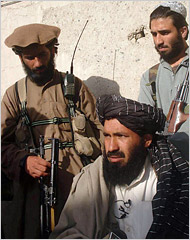
|
| South Waziristan Taliban leader Mullah Nazir [bottom-center]. |
The US killed a senior Taliban leader in one of three drone strikes that took place in the Pakistani tribal areas over the past 24 hours; he had identified himself as an al Qaeda leader and also was favored by the Pakistani state. A separate strike killed a commander in the Movement of the Taliban in Pakistan along with two Uzbeks.
Mullah Nazir, the leader of the Taliban in the Wazir area of South Waziristan, was killed by the CIA-operated Predators or Reapers in a strike in the Birmal area of South Waziristan, tribal leaders and Pakistani intelligence officials told Dawn. The remotely piloted drones fired a pair of missiles at a vehicle, killing Nazir; two of his deputies, Atta Ullah and Rafey Khan; a commander known as Rata Khan; and two other fighters.
Pakistani officials in South Waziristan said that the Taliban buried Nazir at a graveyard in the Azam Warzak area of South Waziristan.
Nazir and his followers have been the targets of numerous US drone strikes in the past several years. Of the 328 strikes since 2004, 81 have hit targets in South Waziristan. Several of Nazir's deputies and commanders have been killed in those strikes.
In a separate strike, US drones killed Faisal Khan, a Movement of the Taliban in Pakistan commander, and two Uzbeks as they traveled in a vehicle in the village of Mubarak Shahi in the Mir Ali area of North Waziristan, Dawn reported. The drones circled back and fired a second salvo of missiles as rescue workers attempted to recover the bodies, but it is unclear if anyone else was killed in the follow-on strike.
Additionally, the US killed five "militants" in a strike that targeted a compound in the Angoor Agga area of South Waziristan late last night. The identities of those killed have not been disclosed.
The US has now launched three drone strikes in Pakistan this year. Last year, the US launched 46 strikes in Pakistan, according to data compiled by The Long War Journal. In 2011, the US launched 64 strikes; in 2010, when the program was at its peak, there were 117 strikes.
The program was ramped up by President George W. Bush in the summer of 2008 (35 strikes were launched that year) and continued under President Barack Obama after he took office in 2009 (53 strikes that year). From 2004-2007, only 10 strikes were recorded. Although some of al Qaeda's top leaders have been killed in drone strikes since the program began in 2004, al Qaeda has been able to replace those lost in the attacks. [For data on the strikes, see LWJ reports, Charting the data for US airstrikes in Pakistan, 2004 - 2013; and Senior al Qaeda and Taliban leaders killed in US airstrikes in Pakistan, 2004 - 2013.]
Background on Mullah Nazir
Nazir has been an influential Taliban commander and had ties to numerous terrorist groups operating in the region, including al Qaeda, the Pakistani and Afghan Taliban, and the plethora of Pakistani and Central Asia jihadist groups operating in the region. He has openly supported Taliban emir Mullah Omar and al Qaeda leader Osama bin Laden, and wages jihad in Afghanistan. In an interview with the Asia Times, Nazir rejected claims that he opposed al Qaeda, and affirmed that he considered himself to be a member of the global terror organization.
Pakistan's military and intelligence services consider Nazir and his followers "good Taliban" as they do not openly seek the overthrow of the Pakistani state and only wage jihad in Afghanistan. The government has negotiated several peace deals with Nazir. Yet Nazir continued to provide safe have to top al Qaeda leaders and the Movement of the Taliban in Pakistan, despite agreeing not to do so.
Several top al Qaeda leaders, including Ilyas Kashmiri, Abu Khabab al Masri, Osama al Kini, Sheikh Ahmed Salim Swedan, and Abu Zaid al Iraqi, have been killed while being sheltered by Nazir. [For more information on Nazir and al Qaeda leaders killed while under his protection, see LWJ reports, 'Good' Pakistani Taliban leader Nazir affirms membership in al Qaeda, and US drones kill 'good' Taliban commander in South Wazirstan.]
Mullah Nazir's Taliban faction is one of four major Taliban groups that joined the Shura-e-Murakeba, an alliance brokered by al Qaeda in late 2011. The Shura-e-Murakeba also includes Hafiz Gul Bahadar's group; the Haqqani Network; and the Movement of the Taliban in Pakistan, which is led by Hakeemullah Mehsud and his deputy, Waliur Rehman Mehsud. The members of the Shura-e-Murakeba agreed to cease attacks against Pakistani security forces, refocus efforts against the US in Afghanistan, and end kidnappings and other criminal activities in the tribal areas.
In June 2012, Nazir banned polio vaccinations in his areas, and claimed that the program is being used by the US to gather intelligence and conduct drone strikes in the tribal areas. His action followed that of Hafiz Gul Bahadar, who shut down the program in North Waziristan earlier that month.
Nazir's death in a drone strike took place just five weeks after he was the target of a suicide attack in Wana in South Waziristan. Nazir survived the suicide bombing, but six other people were killed.